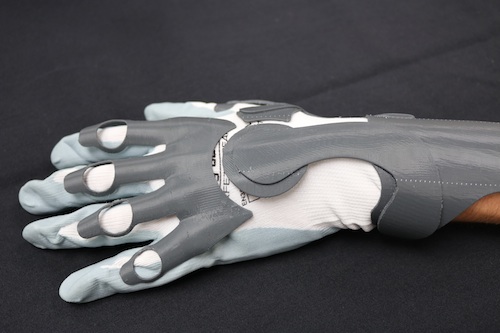3D Printing Takes On Vet Disabilities

As partner in the VA Innovation Creation Series, Stratasys aims to accelerate the development of personalized technologies to improve care and quality of life for veterans. Image Courtesy of VA Innovation Creation Series
Latest News
August 26, 2015
Kim Matthews was all-hands-on-deck during active duty on submarines, but today, the Navy vet suffers from hand tremors that make the simplest tasks a herculean effort. Yet thanks to a recent design challenge sponsored by the Department of Veteran Affairs, Matthews and other veterans may soon have some relief, spurred by creative-minded individuals wanting to help along with a healthy assist from 3D printing.
The VA Innovation Creation Series for Prosthetics and Assistive Technologies came up with a list of common problems veterans face and challenged individuals with backgrounds in engineering, design, and general problem solving to come up with potential solutions. The idea was to foster an open innovation environment, working with partners like Stratasys to provide a set of tools that would empower problem solvers to turn their ideas into working prototypes.
 As partner in the VA Innovation Creation Series, Stratasys aims to accelerate the development of personalized technologies to improve care and quality of life for veterans. Image Courtesy of Stratasys
As partner in the VA Innovation Creation Series, Stratasys aims to accelerate the development of personalized technologies to improve care and quality of life for veterans. Image Courtesy of Stratasys“Being able to rapidly prototype new designs is something 3D printing is clearly well suited towards,” said Michael Gaisford, marketing program manager for medical solutions at Stratasys. “You have complete design freedom with 3D printing—groups were able to come to us with some wild idea and test it out without having to bring in 20 different types of fabrication equipment and machines.”
The five challenges the teams set out to address were:
- Developing novel upper extremity prosthesis devices for everyday usage.
- Creating a pill box with the flexibility to hold medications that need to be taken up to 8 times a day with a reminder system for each time medication needs to be taken.
- Designing a device to remotely change the speed and grip strength of a prosthetic device for vets with upper extremity injuries.
- Creating a device that can dampen tremors when performing fine motor tasks.
- Devising a way to reassign motions and buttons on gaming controllers to provide alternative access for vets who are using them in therapy to improve hand/eye coordination, fine motor control, and/or range of motion.
About 125 people participated in the two-day design challenge held in late July. At their disposal were a variety of design tools, including 14 Stratasys 3D printers, from the high-end Fortus 450mc production-class machines to lower end Mojo and Makerbots. Designs were submitted through GrabCAD, Stratasys' open source 3D modeling and collaboration platform.
One glove design, in particular, has real potential to help Matthews with her hand tremors. The glove provides stability, allowing Matthews to better control her hand movements so she can perform essential job-related skills like typing as well as handle simple every day tasks like buttoning blouses, even drinking coffee.
 This glove, designed to provide stability for hand tremors, aims to improve veteran Kim Matthews' ability to perform everyday tasks. Image Courtesy of Stratasys
This glove, designed to provide stability for hand tremors, aims to improve veteran Kim Matthews' ability to perform everyday tasks. Image Courtesy of StratasysMatthews, who raised three kids and works as an administrative assistant, is hopeful that the designs coming out of this challenge will address vets' issues, leading to better quality of life.
“A lot of these inventions have big potential, not just to help me, but to help other veterans who are far worse off,” she said. “To have something that makes you feel like a human being and a woman is important. We just want to feel normal, and these inventions allow us that capability.”
Subscribe to our FREE magazine, FREE email newsletters or both!
Latest News
About the Author
Beth Stackpole is a contributing editor to Digital Engineering. Send e-mail about this article to [email protected].
Follow DE





